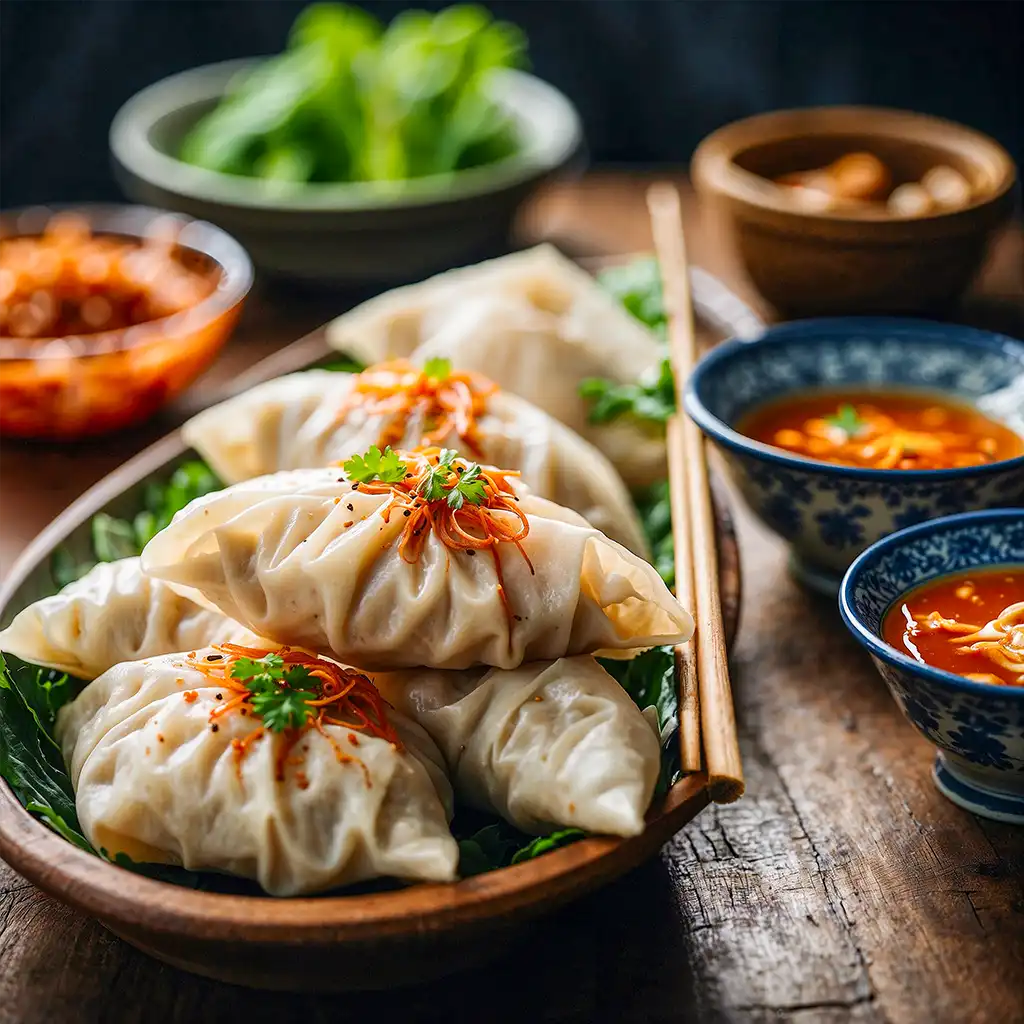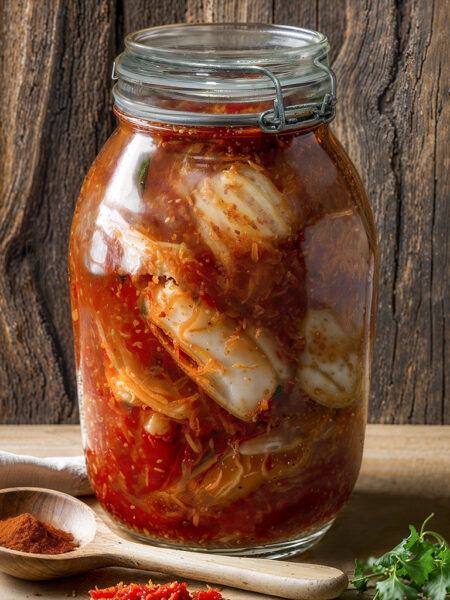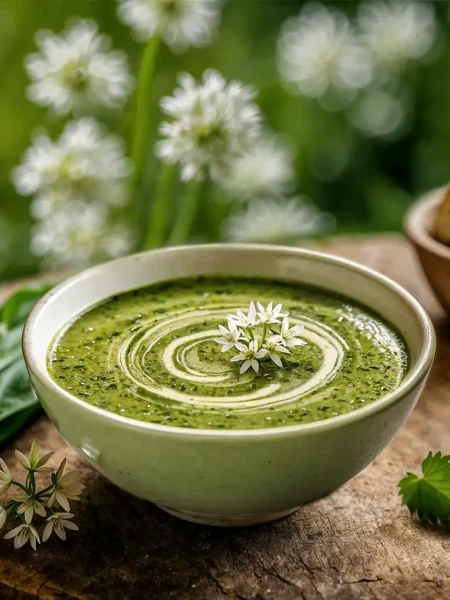Is there anything better than a plate of steaming, aromatic dumplings? I think the answer is simple – few things come close! That’s why I want to take you on a culinary journey to Korea and share a recipe for a dish that has absolutely captured our hearts and taste buds: Kimchi Wang Mandu.
Mandu, or Korean dumplings, are a real phenomenon. They’re not only delicious and surprisingly versatile, but also an important part of Korean culture and cuisine, taking the world by storm. In our home, Kimchi Wang Mandu are an absolute hit – their distinct kimchi flavor combined with the generous filling makes them disappear from plates in the blink of an eye.
But before we start folding, let’s take a little trip back in time. The history of mandu is as fascinating as their taste. Although their exact origins are somewhat shrouded in mystery, many historians believe that precursors to mandu arrived in Korea around the 14th century, during the Goryeo dynasty, likely brought by the Mongols of the Yuan dynasty. Some even suggest earlier roots tied to trade along the Silk Road. Interestingly, the appearance of mandu (often with meat fillings) coincided with the relaxation of Buddhist principles regarding meat consumption in Korea, which certainly contributed to their growing popularity.
So, what about the full name: Kimchi Wang Mandu? As you already know, ‘mandu’ (만두) simply means Korean dumplings. The word ‘Wang’ (왕) means ‘king’ or ‘royal’. However, in the case of these particular dumplings, ‘wang’ primarily refers to their impressive, ‘royal’ size (king-size!) and exceptionally generous filling. It’s this size and generous filling that make them so satisfying and stand out from standard mandu.
Traditionally, mandu were (and still are!) an essential part of celebrating Seollal, the Korean New Year. Entire families would gather to fold hundreds of dumplings together, often shaping them symbolically – like money pouches or coins, believed to bring luck and prosperity. It’s a beautiful tradition that strengthens bonds and celebrates time together.
Today, you can find mandu everywhere – from humble street food stalls serving steaming snacks to elegant restaurants. Regardless of their origin and history, for us, Kimchi Wang Mandu have become a symbol of delicious, homemade food that warms, comforts, and simply brings great joy.
Kimchi Wang Mandu (김치왕만두) – Korean Dumplings with Kimchi
For me, Kimchi Wang Mandu are more than just ordinary dumplings. They're little works of art that capture our hearts (and taste buds!) every single time. Their secret lies in the perfect balance of flavors – the intense, slightly tangy and spicy fermented kimchi, juicy meat, and a delicate, springy wrapper. I usually make the dough myself – mandu-pi (dumpling wrappers) are actually really simple to make at home.
As soon as I start prepping the filling, an incredible aroma fills the whole house. The intense scent of well-fermented kimchi mingles with garlic, ginger, and sesame oil – a smell that instantly makes my stomach rumble! And the taste? The first bite is an explosion of sensations: the spicy-sweet tang of kimchi pairs perfectly with the richness of the meat, the freshness of chives, and the delicate texture of tofu.
In our house, these dumplings hold a special status. We definitely prefer them steamed – they become incredibly delicate and juicy that way. But if you prefer a crispy skin, you can also pan-fry them until golden brown, which is another fantastic option. My wife and older son absolutely adore them, especially that characteristic spicy kick from the kimchi. Unfortunately, our younger son isn't a fan of spicy food, so I always prepare a separate, milder batch for him without the kimchi – thankfully, mandu are versatile enough to be easily adapted!
These dumplings are our favorite dish on chilly days, perfect for a family dinner (we always make a large batch – they are 'wang mandu', after all!). They're also a fantastic way to use up kimchi that's been fermenting in the fridge for a while and has developed a deeper, richer flavor. I admit, folding them requires a bit of patience, especially if you want to achieve those characteristic, neat pleats, but I guarantee – the final result is totally worth it! Besides, folding dumplings together is a really wonderful opportunity to spend quality time together in the kitchen. Could there be anything better than cooking together and then feasting on your own homemade delights?
Ingredients
Dipping Sauce
Instructions
Preparing the meat filling
-
Mix the ground meat with the finely chopped ginger and garlic.
-
Add soy sauce, sugar, sesame oil, and black pepper, mixing everything thoroughly by hand.
-
Heat a pan, add a teaspoon of vegetable oil, and sauté the meat over medium-high heat for about 5-7 minutes, until it loses its pink color and starts to brown. Remember to break up any larger pieces with a wooden spoon.
-
Transfer the meat along with the resulting sauce to a large bowl and set aside.
Preparing the noodles
-
Bring 7-8 cups of water to a boil in a large pot.
-
Add the dangmyeon noodles and cook for 7-8 minutes until soft and elastic.
-
Drain in a colander and rinse thoroughly with cold water to stop the cooking process.
-
Allow the noodles to drain well, then transfer to a cutting board and chop into pieces about 0.4 inches (1 cm) long.
-
Add the chopped noodles to the bowl with the meat.
Combining the filling ingredients
-
Add the chopped onion, chives, and kimchi to the bowl with the meat and noodles.
-
Gently press the excess water out of the tofu using a paper towel, then crumble it with your fingers directly into the bowl.
-
Mix all ingredients thoroughly, preferably with clean hands, until a uniform mixture forms. The filling should not be too wet - if it is, you can add a tablespoon of potato starch.
Shaping the dumplings
-
Place a dumpling wrapper on your palm (if using frozen wrappers, make sure they are completely thawed).
-
Put 2-3 tablespoons of filling in the center of the wrapper, being careful not to add too much, which would make it difficult to close the dumpling. Fold the wrapper in half vertically and seal the upper part, creating a half-moon shape.
-
Starting from the right side, form characteristic pleats along the edge: gently press a small section of the edge inward, pinch to form a pleat, and continue this process moving toward the end, creating a series of pleats in one direction. Pinch the last tip to ensure that the dumpling is tightly sealed. While forming, regularly dust your fingers with flour to prevent the dough from sticking to your hands.
Cooking the dumplings
-
You can prepare the dumplings in two ways: by steaming or frying them.
For the traditional steaming method, line a steamer basket with parchment paper (with holes for steam) and arrange the dumplings on it, leaving spaces between them. Steam for about 15 minutes covered.
If you prefer to fry them, heat a pan. Add 2 tablespoons of oil and spread it evenly by moving the pan. Wait until the oil is well heated - it should shimmer slightly or have a slight "wave" effect (but not smoke). Add the mandu (dumplings) and fry over medium heat, turning them so that each side becomes golden brown. Reduce the heat to low and cover the pan with a lid. Cook for a few more minutes until the filling is hot and the dough is fully cooked.
Preparing the dipping sauce
-
In a small bowl, mix soy sauce, rice vinegar, finely chopped onion, chili pepper, and optionally sugar. Mix thoroughly until the sugar dissolves. You can adjust the proportions of ingredients to your own taste preferences - more spicy or more sweet.
Notes
The nutritional values provided are only estimates. Actual caloric content and nutrient levels can vary significantly depending on the products used (e.g., type and fattiness of meat, type and thickness of mandu-pi dough, kimchi composition), exact quantities, and preparation method (e.g., amount of absorbed fat).
Dumplings can be frozen: first, arrange them on a tray lined with plastic wrap or baking paper so they don't touch, and place in the freezer until completely hardened (e.g., for a few hours). Then transfer the frozen dumplings to an airtight container or ziplock bag. For best results and longest storage, vacuum seal the frozen dumplings. Conventionally stored in the freezer, they will maintain good quality for about 3 months, while vacuum sealing will significantly extend this time (even up to 6-12 months) and help preserve their excellent flavor and texture, minimizing the risk of drying out or ice formation.
If you don't have ready-made mandu dough, you can use gyoza wrapper dough or make your own.
This recipe assumes the preparation of fairly large dumplings (hence the amount of filling per piece and the name 'wang'), but you can of course adjust their size to your own preferences.
If you want to prepare a vegetarian version, skip the meat and increase the amount of tofu and vegetables.
The kimchi used for the filling should be well-fermented - the older, the better, as it then has a more complex, deeper flavor. If you prepare kimchi yourself, you can use it for dumplings when it reaches the peak of fermentation and begins to be distinctly sour.
In Korea, mandu are served in many ways: as a snack with dipping sauce, in soup (manduguk), or fried until crispy (gunmandu). Each preparation method gives them a different character and emphasizes different aspects of their flavor.





